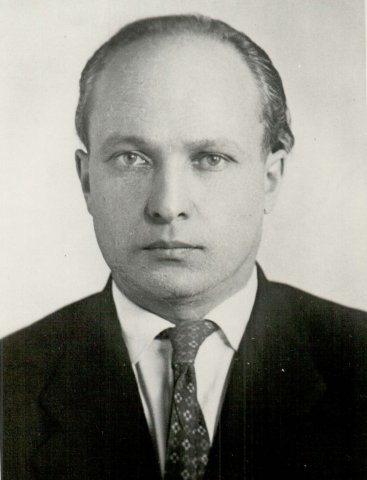06.04.1915 - 30.01.1973
1941 - graduated from M.V.Lomonosov Moscow State University (MSU)
1945-1959 - Physics Institute of the USSR Academy of Sciences, Moscow
1959-1973 - LNP JINR, one of the LNP founders, Deputy Director
1962 - Doctor of Sciences (Phys. and Math.) defended in ITEP (Moscow)
1968 - co-author of the discovery “Phenomenon of retention of slow neutrons”
1967 - Professor of M.V.Lomonosov Moscow State University
1968 - Corresponding Member of the USSR Academy of Sciences
1971 - laureate of the State Prize
1977 - laureate of the I.V.Kurchatov Prize of the USSR Academy of Sciences
F.L. Shapiro belonged to the generation that came to the science later than the others did. After his graduation from M.V.Lomonosov Moscow State University in 1941 he, as well as his contemporaries, fought at the war. And only in 1945 he was accepted to the Physics Institute of the USSR Academy of Sciences as a post-graduate student to I.M. Frank with whom he worked closely in all the succeeding years of his life. In 1946 F.L. Shapiro, an assistant of the chair of nuclear physics in MSU headed by I.M. Frank, lectured on neutron physics and organized practical work on nuclear physics. In 1947 F.L. Shapiro was taken on as a junior research assistant to I.M. Frank’s Laboratory and took part in the investigations of subcritical uranium-graphite assemblies using the prism method. In these studies the important data for reactor engineering were obtained and some aspects of reactor physics were specified. In the early 50s Shapiro’s group proceeded to the practical realization of the neutron slowing-down spectrometry in lead. On this spectrometer for the first time the neutron radiation capture cross-sections for more than ten nuclei were measured and a number of effects became a scientific sensation, namely the deviation of cross-sections from the 1/v law that had been assumed to be universal for all nuclei. In addition, in the course of work on the “lead cube” (lead slowing-down spectrometer) F.L. Shapiro suggested the method of unsteady-state neutron diffusion in multigroup approximation and developed it with M.V. Kazarnovsky, a theoretician in his group. These works received wide recognition and F.L. Shapiro presented them at the Geneva Conference on Peaceful Uses of Atomic Energy in 1955.
In 1958 I.M. Frank proposed that F.L. Shapiro combine his job in the Physics Institute with the work in the Laboratory of Neutron Physics (JINR) headed by him, where the construction of a pulsed reactor on fast neutrons was already underway. Feodor Lvovich agreed and rather quickly became deeply involved in the work of the Laboratory.
At the same time F.L. Shapiro together with I.Ya. Barit and M.I. Podgoretskii proposed an experiment using a just discovered Moessbauer effect to verify the consequence of the relativity theory to observe a photon frequency shift in gravitational and inertial fields. In the experiment conducted in LNP, velocity spectra of a narrow gamma-line of Zn67 with a record to the present day relative energy resolution of about 10-15 were obtained, but the effect appeared to be too small and insufficient to be used in a gravitational experiment. Later on American physicists were the first to perform an analogous experiment with another isotope.
In 1960 the IBR reactor was put into operation and the investigations of total and partial neutron-nucleus interaction cross-sections on its beams began. On one of the beams the method of neutron beam polarization suggested by F.L. Shapiro by passing neutrons through a polarized proton target was successfully tested. On this installation the spins of neutron resonances of some nuclei were measured and a set of amplitudes for neutron-deutron scattering at small energies was determined. Later on the installation was used for other experiments, in particular, the resonant amplification of P-violation effect was discovered on it.
In 1961 F.L. Shapiro suggested that the IBR reactor be used for condensed matter investigations. He proposed the inverse geometry method characterized by higher luminosity that made it possible to study atomic thermal vibrations in solids and to measure the self-diffusion coefficient at a liquid-vapor critical point, which refuted the results of numerous macroscopic experiments that suggested the termination of diffusion at a critical point. F.L. Shapiro together with Polish physicist B.Buras has substantiated the application of the time-of-flight method for diffraction studies of structure of matter. In FLNP with the direct participation of F.L. Shapiro the neutron diffraction method was applied for magnetic structures in strong pulsed fields.
In 1968 F.L. Shapiro proposed a way to test the validity of the time parity conservation law in the experiment on observation of a neutron electric dipole moment. He suggested that this extremely weak effect could be observed only for very slowly moving (ultracold) neutrons. This idea got a skeptical reception from many physicists since a share of UCN in a reactor beam did not exceed one hundred milliardth. The IBR beams were very weak, but nevertheless in the summer of 1968 F.L. Shapiro with his colleagues successfully carried out the experiment on first observation of UCN. Within a few years this result was registered as a discovery. Further studies with UCN were transferred to more powerful stationary reactors.
I.M. Frank used to repeat that he was only a director and the whole “science” in the Laboratory was in charge of F.L. Shapiro. Of course, it was not quite so. I.M. Frank, Academician, the Nobel Prize winner was a very shrewd and far-sighted leader – he saw a powerful generator of ideas in Shapiro, gave him freedom and opportunities for their realization. Shapiro’s ideas underlay the majority of investigations carried out in the Laboratory, not because he was of higher rank, but because among all suggested ideas his idea used to be the best. It was a great piece of luck that such two persons as I.M. Frank and F.L. Shapiro met and successfully supplemented each other.
